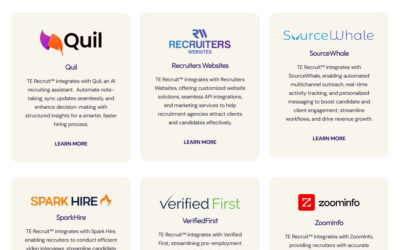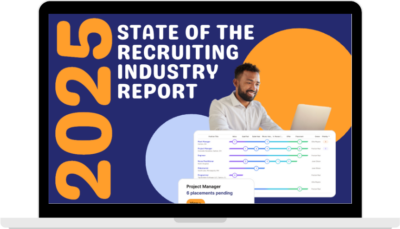(Editor’s note: The information from this article by Top Echelon Recruiting Software has been taken from an Expert Recruiter Coaching Series webinar by Brad Bialy of Haley Marketing titled, “What the Best Recruiting Firms Do Differently.” Click HERE to watch the video of that training webinar for free.)
Recruiting is a game of speed, strategy, and relationships. Some firms dominate year after year, while others struggle to keep up. What separates the perennial high-performers from the rest?
Brad Bialy, Director of Digital Marketing at Haley Marketing and host of The Secrets of Staffing Success podcast, has spent over 12 years working with staffing startups, mid-sized firms, and national giants. His conversations with industry leaders, coupled with real-world observations, have revealed a consistent set of habits that set the best recruiting firms apart.
“Whether you’re a one-person shop or a $500 million agency,” says Bialy, “there are certain principles that, if you commit to them, will fundamentally change how you do business.”
Below is a deep dive into those principles—expanded from Bialy’s webinar presentation into a full 2,000-word playbook.
1. They Start With a Clear Vision
Top recruiting firms don’t leave success to chance. They have a defined vision for where they want to be in the next year, five years, or even decade—and they measure progress relentlessly.
Brad often references a timeless lesson from Napoleon Hill’s Think and Grow Rich:
“Weak desires bring weak results. A small amount of fire brings a small amount of heat.”
For elite firms, vision isn’t a vague wish like “We want more placements.” It’s a quantified, measurable target—e.g., “We want 350 placements by this time next year”—paired with the math to get there.
They reverse-engineer these goals:
-
Annual → Quarterly → Monthly → Weekly → Daily
-
They know how many job orders, submissions, and outreach activities are required each day to make hitting the goal almost inevitable.
Bialy challenges recruiters with a reflective question:
“If someone followed you for a week, would they be able to tell what your goals are just by watching your daily actions?”
Action tip: Write down your annual placement target, break it down into the exact daily actions needed, and make those actions visible to your team.
2. They Know Who They Are—And Who They’re Not
Recruiting can feel like a commoditized industry. “At the end of the day, we all put great people to work in great opportunities,” Brad points out. The differentiation comes from how you deliver.
High-performing firms identify:
-
Their core strengths (industries, job types, service models).
-
Their unique selling points (speed, candidate quality, specialized expertise).
-
What they don’t do.
They resist the temptation to imitate competitors. Bialy recalls a client who wanted to copy a rival’s website design exactly:
“We turned down the project. There would’ve been no reason for anyone to choose them if they looked and acted just like their competitor.”
Action tip: Document three reasons a candidate should trust you with their next career move and three reasons a client should trust you with their job orders. Build your marketing and sales scripts around those points.
3. They Find—and Follow—Their Coach
Even world-class athletes have coaches. Top recruiting firms do too.
Bialy compares it to training for a marathon. For his first Buffalo Marathon, he hired a running coach, consulted a physical therapist, and followed a detailed nutrition plan.
“There are thousands—if not millions—of coaches out there. The best recruiters have the courage to pick one, put on blinders, and follow the plan.”
The danger lies in “coach-hopping”—jumping from one methodology to another before any has a chance to produce results.
Action tip: Choose a sales, recruiting, or leadership coach whose methods align with your vision. Commit to following their process for a full year before evaluating.
4. They Embrace Change
The recruiting landscape shifts quickly. Economic trends, hiring freezes, technology, and candidate expectations can make last year’s playbook obsolete.
“What got you here won’t necessarily get you there,” Bialy says. “The best recruiters aren’t stuck in pre-COVID strategies. They adapt.”
He notes that while the staffing industry as a whole has seen slow growth recently, top firms refuse to accept negative forecasts as their personal reality. They adjust their tactics to find opportunity.
Action tip: Audit your current strategies. Ask: If we were starting fresh today, would we still do it this way? If the answer is no, it’s time to adapt.
5. They Use AI and Automation With Purpose
Artificial intelligence is no longer optional—it’s a force multiplier. But Bialy warns against chasing every new tool for novelty’s sake.
Instead, he cites a framework learned from Trisha Tamkin of Moore Essentials:
“Leave a sticky note on your monitor that says, ‘How can AI help me with [this task]?’”
High-performing firms:
-
Use AI to draft outreach templates.
-
Automate CRM updates.
-
Personalize candidate follow-ups at scale.
-
Deploy marketing automation to stay in front of prospects.
Action tip: Identify one repetitive weekly task and research how AI or automation could handle it. The freed-up time can then be used for relationship-building.
6. They Act as Consultants, Not Order Takers
Transactional recruiting—waiting for a client to send an order and then filling it—is fading fast.
“Gone are the days of just asking, ‘Anything I can work on for you?’” Bialy says. “Top recruiters anticipate client challenges before the client even sees them coming.”
They understand industry cycles, seasonal hiring trends, and the ripple effects of each placement on a client’s organization. They make strategic recommendations rather than waiting for instructions.
Action tip: Before your next client meeting, research their industry news, hiring patterns, and competitors. Bring at least one proactive suggestion to the conversation.
7. They’re Multi-Focused: Candidates and Clients
Some firms lurch between candidate shortage and client shortage. Elite firms maintain both pipelines at all times.
They run:
-
Recruitment marketing (social ads, job boards, referral programs).
-
Client marketing (email campaigns, LinkedIn content, events).
-
Tailored messaging for each audience.
Bialy warns against the “swinging pendulum” approach:
“It’s not candidates or clients—it’s candidates and clients. You can’t let one side of the business starve while you feed the other.”
Action tip: Review your last three months of marketing. Was it balanced? If not, add at least one campaign for the neglected audience.
8. They Obsess Over Experience
Experience is the “cherry on top” that turns satisfied candidates and clients into loyal advocates.
Bialy explains:
“It’s that ‘Wow, they didn’t have to do that for me’ moment. That’s what sticks.”
Elite firms:
-
Test their own application process on mobile and desktop.
-
Ensure clients can submit job orders outside 9–5 hours.
-
Personalize follow-ups and thank-yous.
Brad suggests a hands-on test:
“Have someone you know apply to a job on your site. Don’t watch their screen—watch their body language. If they get frustrated, imagine how a stranger feels.”
Action tip: Streamline every touchpoint. If it takes more than a few clicks to apply or submit a job order, fix it.
9. They Market With Purpose
Random acts of marketing don’t work in a noisy digital environment. Every marketing activity must have:
-
A defined audience.
-
A specific goal.
-
A way to measure results.
“Every post has a purpose,” says Bialy. “If it doesn’t, you’re just adding to the noise.”
Top firms map content to each stage of the client or candidate journey, ensuring relevance and timeliness.
Action tip: For each post, email, or ad, ask: Who is this for? What do I want them to do next? If you can’t answer, rework it before publishing.
10. They Integrate Marketing and Sales
It can take 17–20 touches for a prospect to even register your existence. Some research suggests up to 70. Yet most sales reps give up after four attempts.
“You’re not reaching your prospects enough,” Bialy stresses. “Marketing and sales need to work together to surround your prospects with consistent messaging.”
High-performing firms create “surround sound” campaigns:
-
Cold calls backed by targeted LinkedIn ads.
-
Email sequences reinforced with retargeting ads.
-
Direct mail timed with sales calls.
Action tip: Audit your sales process. Add marketing touchpoints before, during, and after direct outreach to keep your brand top of mind.
11. They Keep Social Media Human
Automation can schedule posts and draft captions, but it can’t replace real conversation.
“We have a funny way of messing up marketing,” Bialy laughs. “We find something that works and then exploit it until it doesn’t.”
The best recruiters treat LinkedIn, Facebook, and other platforms as relationship hubs:
-
Commenting on client and candidate posts.
-
Sharing useful industry news.
-
Responding quickly to messages.
Action tip: Spend 15 minutes daily engaging with your network—not just posting. Relationships grow in the comments section.
Putting It All Together
Here’s a condensed view of what the best recruiting firms do differently:
-
Have a clear vision and reverse-engineer it into daily actions.
-
Know their identity and avoid being a commodity.
-
Commit to one coach or methodology without distraction.
-
Embrace change instead of clinging to old habits.
-
Use AI and automation with deliberate intent.
-
Consult rather than take orders.
-
Maintain a dual focus on candidates and clients.
-
Obsess over the experience for both groups.
-
Market with purpose and measurable goals.
-
Integrate marketing with sales for multi-channel presence.
-
Keep social media authentically human.
Final Word
The difference between average and exceptional recruiting firms isn’t just in effort—it’s in direction. The top players align every daily activity with a bigger vision, adapt quickly, and never lose sight of the human relationships at the heart of the industry.
“Success in recruiting compounds,” says Bialy. “Every improvement builds on the last. Before long, you’re not just surviving—you’re leading.”









